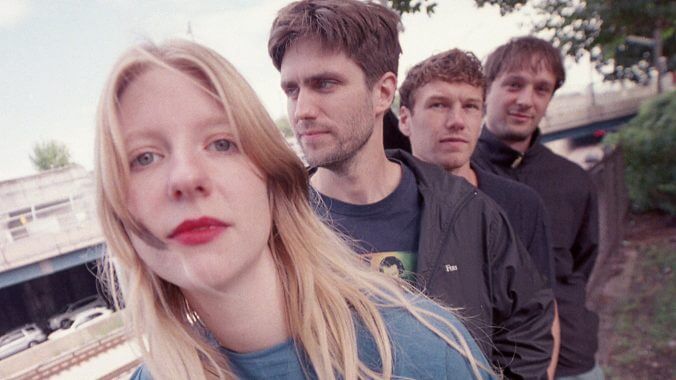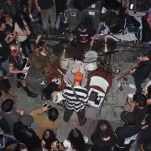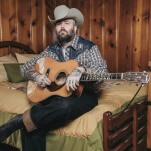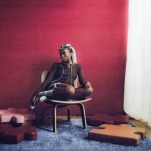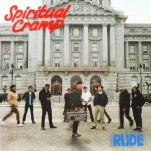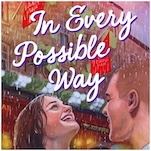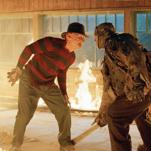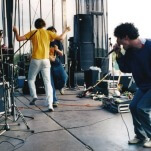You can thank Guns N’ Roses, Jack Black and Good’nLoud Music for the birth of Slow Pulp, the Chicago-via-Madison quartet of vocalist/guitarist Emily Massey, bassist Alex Leeds, drummer Teddy Mathews and guitarist Henry Stoehr. Once upon a time, when Leeds, Mathews and Stoehr were 12 years old in Southern Wisconsin, they found a divine obsession in stadium-sized rock ‘n’ roll—an origin story that knows no geographical bounds and probably sounds pretty familiar to anyone who’s been young and wanted to be a star. They called their first band P.A.T.H.—an acronym for Paul, Alex, Teddy, Henry. “It was between that and Clear Blood,” Mathews interjects, laughing. Massey grew up on the east side of the city, while Leeds, Mathews and Stoehr came up on the west side—though Stoehr and Massey’s parents were friends in high school, they didn’t know each other back then. There wasn’t much crossover at all, actually, but they each took music lessons at Good’nLoud Music, a beloved instrument shop and instructional space on University Avenue that closed its doors back in 2010. “The DNA of the band, we definitely owe a lot to that music education program,” Leeds adds. “It was our School of Rock before those existed, but we had School of Rock the movie. And that’s definitely a part of our DNA, too.”
If you’ve ever gotten really stoked on that one School of Rock scene—where Jack Black is instructing the class with a gigantic diagram breaking down every subset of rock ‘n’ roll—then you can definitely see a similar amalgamation in Slow Pulp’s work. I remember copying that chart verbatim into a notebook way back when, and I’ll bet Massey, Leeds, Mathews and Stoehr might have done the same—because, when you listen to their two albums Moveys and Yard, you can hear the stems of a dozen reference points and a limitless history of DIY, bedroom and alt-rock. The constructional world of the band is like a sponge; from the twang and pedal steel emoticons of “Broadview” to the Y2K stylings of “Doubt” to the sludge and grunge of “Cramps,” there’s finesse and attention and, yet, such a distinctive, original flair.
Massey met Stoehr and Mathews in college and, after working on some tunes with Mathews in her parents’ basement, she was formally brought into the band as an auxiliary member—tapped to play rhythm guitar and sing back-up vocals in 2017. That fact might come as a surprise to some, given that Massey has become the voice at the front of the Slow Pulp we know and adore in 2023—and her ascension to songwriter, melody maker and lead singer is an unorthodox evolution. But, in the half-decade since Slow Pulp grew into itself, Massey has become one of the most wondrous lyricists, while Stoehr has taken a great shine to production work and the band, as a whole, have never been tighter. I’ve encountered a recent trend where nearly every great indie band comes into focus sounding like their destiny to make bold, curious music together was not one that they had to pull out of thin air or will into existence. I’m thinking of Truth Club and Wednesday and Squirrel Flower, among countless others who reside in a sonic ecosystem alongside each other but all flaunt distinctive savvy. With Slow Pulp, that is the truth, too.
My bias for Midwestern rock bands can be boiled down to a molecular level at this point, as I’ve lived my whole life in the region and my heart has been affixed to music since I got a Beatles CD for Christmas when I was four. There’s an affinity there, though, for power chords and distortion dreamt up on the edges of the Great Lakes and for talent and excitement coming from my neighbors. Stoehr notes that the music scene in Madison is always changing and that that’s mostly a product of the University of Wisconsin having a lot of force in shaping local cultural tides—but the core coding of Slow Pulp came from DIY fixtures around the city. “Whenever we were doing a Madison thing, it was really centered around exciting live shows,” Stoehr says. “There’s something to say about the college music scene when we were there,” Massey adds. “Artists like Porches or Alex G were really coming up—and, I think, are still influential to our music, in some regard. College is a really great time to get into smaller, independent music, and that was a shared thing throughout the scene. That felt very pertinent.”
The core Madison sound, however, remains indebted to garage and punk-adjacent music through and through—and, even as Slow Pulp have migrated to Chicago, you can still hear a pride for Wisconsin and a historical sound. What’s going on in the city now shares a similar ethos to what was going on in the 1980s when bands like Hüsker Dü and The Replacements were dominating left-of-the-dial college radio and buoying underground scenes while clawing lightly at mainstream recognition. “It’s cool to see how many similarities exist in that time period to the mid-2010s when we were there,” Massey says. “I don’t know how to describe it, other than there is something distinctly Midwestern about that—and not having such big resources that a lot of the coasts might have for shows and venues and spaces. I think, naturally, having DIY spaces and house shows create an environment to just thrash, for lack of a better term.”
When Massey brings up a peer like Alex G, he’s a bright, shining example of how, if the light hits just right, folks who cut their teeth on making lo-fi, hermetic weird shit can taste the fringes of stardom. Now, he’s about to open gigs for the Foo Fighters. Slow Pulp are on a similar trajectory, having already shared tour bills with Death Cab For Cutie and the Pixies. In the band’s early days, after putting out EP1 and EP2, they started going on tour with fellow Chicagoans like Whitney, Post Animal and Twin Peaks and Paul Cherry—shows that became essential in helping them cultivate audiences before even having an LP out. Like Madison, Chicago’s music scene is a revolving door, too, so having such a strong kindness shown to them by established artists locally was a godsend. “We were lucky to have friends that were willing to put us on like that,” Leeds notes.
You’d think that going from playing a bar like Subterranean in the Wicker Park neighborhood of Chicago to playing 3,000-cap venues like Usher Hall in Edinburgh, Scotland would be a jarring change of pace for a band just breaking big, but, for Slow Pulp, it’s the opposite. “I will say, I feel so much more nervous playing DIY shows where there’s, like, 50 people there,” Massey says. “I remember there was a show with Death Cab where I was like, ‘Oh, my God, I feel like that scene in The Lizzie McGuire Movie where she’s playing a coliseum in Rome and there’s just a sea of people.’ She’s having this big moment, and I was like, ‘Oh, this is exactly what it’s like in the movies.’ Sometimes, it does feel totally surreal and pretend.”
In October 2020, Slow Pulp put out their debut album Moveys—a record they’d been working on since the spring of 2019. The course of production on that project had initially stalled for a moment, as they rerouted their direction once Massey was diagnosed with Lyme disease and chronic mono. Before I had ever really bought stock in what Slow Pulp was selling, I felt some type of representation within the body of the band’s work. As a chronically ill person who also makes art, I get what it means to reconfigure a life after a diagnosis and I get what it means to center your creativity around the hope of just feeling good. To listen to a beautiful, flourishing record like Moveys and know that it was fully born from a period of emphasized self-care, that accessibility is indescribable. Massey’s routines on show days haven’t changed much—mostly because, according to her, the band rarely have days off because their drives are long and they tour-manage themselves—but she admits that she possesses a superpower: She can almost always sleep in the Slow Pulp van, which is a gift I could only dream of holding.
“My illness, it really goes in waves and I think I, maybe, have the more unhealthy mentality of ‘Oh, you just have to push through it,’” Massey says. “But I’ve been trying to create more space for rest. I often get caught in this trap of when I’m not doing something, or when I am giving myself the space to recharge and take time to heal or feel better, I feel guilty that I’m not doing other things. And then, when I’m feeling bad while I’m doing something, I’m feeling guilty that I’m not resting. There’s this pull that I’m trying to balance out and allow myself to take a break and to be more communicative about needing some time off or getting space to just be—because sometimes, for me, I disassociate pretty hard when I’m not feeling my best, health-wise, and I’m in a work setting. I’m working through that, to be able to communicate with people when I’m capable of things or, simply, not capable of doing some things.”
Many of the songs of Moveys, like “Idaho” and “Montana” and “Channel 2,” came together during a tour with Alex G in the fall of 2019. However, in March 2020, Massey’s parents were injured in a serious car accident and she had to return to Madison to take care of them. When COVID restrictions and lockdowns fell upon the United States shortly after, Moveys was completed long-distance. Before making Yard, Massey tapped back into that mode and retreated to a friend’s family’s cabin in Northern Wisconsin, where she was able to chart her own examinations of the world around her in a place of solitude. When she gets there, she spends a day crying—purging all of what she’d built up between trips, an emotional reset that finds its way onto the songs she writes.
“It really allows me to be vulnerable,” Massey says. “I have spent a lot of time hiding from myself in some capacity, hiding from things that might feel hard to process through. And, when you’re alone—and especially when you’re writing, for me—it feels like the wall comes down, and something that’s been really important about that space is to give myself the time to fail and to make things that are not going to make the record, something that nobody will ever hear. Being in a cabin in Northern Wisconsin, I’m confident that nobody will hear it. In my apartment—recently, my neighbor came out in the hallway and was like, ‘You’re the singer! I hear you singing all the time.’ That made me want to die. I just have to sing for hours to get it out, and there’s a lot of stuff that’s pretty bad that comes with that.”
On the flipside of having the freedom to mess up comes the ease of spiraling while in isolation. It’s easy to get way too in your own head when no one’s around to pull you out of it, and negative spaces are devilish in that regard. But Massey is always able to center herself by remembering the people and the community she holds back home that she gets to return to—which allows her to take her time in the cabin and fill her cup all the way up again. So much of Moveys zeroes in on imagery of movements and places. On Yard, that focus pivots towards untangling interpersonal interactions and this search for magic in acts of comfort. Having put out a record during the apex of a pandemic, the relationship between contradicting forces of isolation and collaboration have become a fixture of Slow Pulp at this point.
“It’s something that I stumbled upon, in terms of writing on my own, that I found to be incredibly cathartic and it really allowed me to be vulnerable and open with myself in ways that I, maybe, didn’t think possible,” Massey says. “When you go somewhere when you’re completely alone, it can kind of go one or two ways—and it still does. Not every time is this perfect romantic time where I’ve got my cup of tea and I’m writing songs that I love every day. A lot of the days are spent really being hard on yourself or really being sad and lonely and longing for that community. But it’s something that I want to continue, at least in my process. Sometimes, you just need the time and space to push something through. It’s kind of random, when we are collaborative. It’s lovely, too. Being given the trust and space to do that, that feels collaborative in its own way. Everyone else, even if they’re not directly in the moment of creation, they’re trusting you with yours—which I think is really important and really special.”
Because of COVID, Slow Pulp wasn’t able to have a headlining tour in support for Moveys until November 2021. Waiting an entire year to finally take the songs out on the road changed the band’s relationship to the album. There was this—at least for me and, maybe, for the crowds, too—element of nostalgia by the time we were able to tour it,” Leeds says. “People had been able to sit with it through the pandemic and I think it took on a different meaning for a lot of them over that time.” “Until we did the tour, I didn’t know whether or not anyone actually listened to our music, because we had never done a headline tour,” Stoehr adds. “The album is just out and I’m like, ‘Would people go to the show? Did people listen to it?’ It was exciting to do the tour finally, but it was hard to gauge immediately who was listening to [Moveys]. It was definitely a relief when we finally did get to tour.”
The songs of Moveys remained dormant after their release, too. The band hadn’t played music together during lockdown so, when they started to piece out the live iterations of the work, they had to relearn them. “We’re doing that again with [Yard], to get ready for our tour coming up, but it had a much different kind of process and meaning getting together and being able to play those songs [from Moveys] that we never actually had played live together,” Massey explains. “Even in the recording process, it was all solitary and independent. I think I gained another understanding of the songs when we were able to do them as a group and do it together. It felt really special.”
Virtually none of Yard was composed before that headlining tour, save for “Doubt,” which came together while Slow Pulp was rehearsing for their upcoming gigs at Palisade Studios near Chicago’s Old Town neighborhood. When the tracking for Yard started happening in the summer of 2022, everything was being built off of acoustic guitar and vocal demos. The quartet would take the songs from that origin point and play them over and over again, fleshing out their parts together—a routine they couldn’t do on Moveys. They got to see the songs take shape in a grander form in real time, not just in bits and pieces. All of the basic tracks—bass, drums, guitar and vocals—were done live on this record, something Slow Pulp hadn’t done with such immensity since their DIY days in Madison. The trend of 2023 has appeared to be—at least to me, across the dozens of interviews I’ve conducted—the “band in a room” sound, and it’s a global practice at this point. Slow Pulp wanted to harness that approach on this album, too, but it became apparent to Stoehr—who produced Yard himself—that the sound was meant to transcend the confines of just four people in a space playing coalescing at once. “For me, part of our sound that I’m attached to is things that are distinctly not live-sounding instruments,” he says. “I was romanticizing the live recording thing, until I had that realization of ‘No, I want a couple of unnatural things happening.’”
Massey’s dad helped her record all of the vocals for Moveys, and he returned again to help her record them for Yard, too. Having him become so instrumental in constructing a piece of the Slow Pulp world has become such a special facet of their relationship, that they get to explore creative collaboration and guidance together. There’s something crucially intimate yet terrifying about working on such personal lyrics so closely with someone who greatly understands the stories’ contexts, but Massey was able to take risks in her lyrics on Yard in ways that she just nervous to strive for on Moveys—given how much of a toss-up working with family can be. But their communication with each other has reached new, rewarding depths far beyond the catalog of Slow Pulp.
“A positive thing for us is being able to fight well. We’re able to passionately argue about things, but we end up seeing another side of it—because we have just created this way of navigating that. He’s great at figuring out the little microcosms of things that could change, he can hear the tiniest opening of my voice and try to take it in that direction. He purposefully was poking at me while we were recording ‘Cramps,’ and I got really pissed off before I recorded the final take of that song. It helps the energy, and it’s those little things that add up and create the best-delivered take, I think. And I’d do it again, I’ll do it on the third [album].”
Massey’s writing on Yard cannot be understated, either. It’s some of the best lyricism of 2023, in fact. I usually refrain from asking musicians about the stories behind certain songs, mostly because anyone listening to them is going to interpret the language in whichever way best suits what they need. However, I couldn’t resist bringing up “Broadview,” a front-runner for song of the year—because Massey takes the song to vulnerable and visceral heights, especially when she sings “Am I wrong? Or is it okay to stay inside and out of love? Tell me I’m wrong. I’m just gonna give it a try and hope that it’s enough” in one of the most devastating, angelic and beautiful vocal phrasings in recent memory.
“The song started as a guitar part that Henry had written and sent to us and, one day, I took it and sang a million things over it,” Massey says. “I was struggling to find what it was going to be. I remember being really frustrated at one point and then taking a break and then coming back and having all of the melody reveal itself to me. I had been singing all day, so my voice was super warmed up and I was able to just open my voice up in a way I didn’t think I could. It was a weird kind of fluke that happened.”
And, I can’t let the pedal steel and harmonica combo from Peter Briggs and Willie Christianson that coats “Broadview” in peak indie twang go unchecked. It’s the moment where Slow Pulp—one of the most promising post-punk outfits in the world—careens into country and fashions Yard into a full kaleidoscope of distinct, multi-orbit elements. The band had been noodling on the structure of the instrumental during practice; they were out of ideas for the day but, at the end of the session, the arrangement came and they recorded it on a phone for Massey to put vocals on top of. The original version of the song sat as a jazzy, swinging folk interpretation of Slow Pulp’s core sound for a long time, until Stoehr went and saw his friend Tyler Fassnacht’s band TS FOSS play a set—and Briggs was playing pedal steel in Fassnacht’s crew, and his playing led to Stoehr having the revelation that that was the instrument needed to fill “Broadview” out completely and give it the color that, as a result, spans across all of Yard.
What makes Yard so rewarding, though, is how much of a case study of juxtaposition it is. A track like “Mud,” which is energetic and funky, props up against the title track, which is this gorgeous piano ballad. The way that Slow Pulp challenge themselves from a record to record and song to song basis is one of hands-off vibe harnessing. “We’re really trying to write songs and let them lead the way forward and not fight what is happening with them,” Leeds says. “Yard” was once a heavy, maximal smorgasbord of sounds, a track that Slow Pulp wanted to push to its limit. “I think we were scared of—or, personally, I was scared of—simplicity,” Stoehr adds. “The song is gonna do what it wants to do, you can’t force it to be anything other than just what it is. On [Yard], that was an underlying philosophy.”
Part of the process on Yard was letting the early stages of each song inform the final versions. “Fishes” was began sparse and ended up, naturally, in a nearby realm; the original demo of “Gone 2” was low-key and went through different, louder and denser variations until the band brought it back to the acoustic guitar-driven melody it arrives on Yard with; “Cramps” was written intentionally in a jam band mindset and the track’s arrangement was informed by Slow Pulp’s collective energy rehearsing it. And, beyond the ways in which the band have figured out how to best serve each other’s creative instincts, they’ve made it to a place where individual needs weigh as greatly as those of the collective. When you listen to a Slow Pulp record, what becomes most noticeable is that each song sounds like it was made by four people who love and care deeply about one another. It’s a fleeting warmth, but one that we ought to have at our fingertips for as long as Massey, Stoehr, Mathews and Leeds are doing this dance together.
“The most important thing to maintain, for me, is a strength and a relationship that we have interpersonally, and our ability to communicate not only about music but about life and things that might come up that we need to work through outside of creativity and within it,” Massey says. “Just getting better at that makes our base so much stronger and more vulnerable and more open. It’s easier for us to be vulnerable with each other. Honing our craft and getting better at playing and songwriting and having a live show that is evolving and being presented the best way we can is important but, really, at its core, it’s about friendship.”
In just three years, Slow Pulp have leveled up to seismic proportions. What once felt like the best-kept secret in indie rock is now a budding phenomenon. Folks are taking notice of Massey, Stoehr, Leeds and Mathews’ chemistry together, and the widespread critical acclaim of Yard is more than earned and deserved. Slow Pulp are at an apex when they crank up the distortion and absolutely wail, like they do on “Worm” or “Doubt,” but there’s something beautifully tender about the Sheryl Crow-ism of “Carina Phone 1000” or the spectral hymnals of “Fishes.”
Even on a Moveys track like “Montana” you could see the hints of slacker-infused, psychedelic post-punk taking turns basking in the sun-soaked whistles of a cowboy harmonica. Slow Pulp were never meant to fade into the static of routine; they were always going to break the mold before it even finished drying. I can’t say for certain what the future of rock ‘n’ roll looks like in the Midwest is going to look like the next time Slow Pulp sit down to make their third album, but I’m sure they aren’t going to play it safe. I think about the ethos of School of Rock, this idea that one great rock show can change the world. It’s a mantra that made kids like Slow Pulp and kids like me and kids like you want to pick up an instrument and start a band with our best friends in the first place, and I think it ought to be applied to records, too. Yard sounds like a revelation, and listening to it might just set you free.
Matt Mitchell reports as Paste‘s music editor from their home in Columbus, Ohio.
